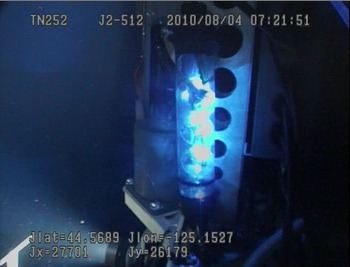There is something different about Enlighten’10 and no, I’m not referring to the R/V Thompson’s new interior paint job. Nor do I refer to the bright faces and high spirits of the new students, faculty, and crew. I’m not even thinking of the ROV Jason'’s presence, or Sentry’'s new sonar, or that this is the first official OOI sponsored cruise. All of these certainly count to make this cruise special. What I am thinking of though, is that this year, ASU is finally getting her feet wet by bringing aboard three scientific instruments to test in the ocean.
I’d like to take the time just now to talk about the first of these experiments, a project we call David’s Spheres. Named after David Ganger, the electrical engineering undergraduate who played a central role in their design and construction, each David Sphere is capable of sensing its environment and wirelessly communicating its state.
A single David Sphere is a light-emitting crystal ball, about 3” in diameter. Their hardness makes them impact resistant and indeed, during their construction, we had fun bouncing them back and forth off the concrete floor, making the lab sound like a pool hall. What makes them work in the deep ocean though is not their hard exterior but rather their squishy inner core. This allows for compression under extreme pressures without an equivalent increase in internal pressure. At the incompressible-compressible boundary we have integrated sensors, optics, electronics, and a rechargeable battery bank. On this cruise we have hardwired them to a battery that allows them to operate for over a month.
It's important to note that David's Spheres operate with no internal processing. They communicate their sensor state by the intrinsic oscillatory nature of their integrated electronics. David’s Spheres are the first step toward fulfilling our dream of the “sensorbot.” For a description of the sensorbots please see the article I wrote about them during the Insite’08 expedition: http://ooi.ocean.washington.edu/cruise/log/show/18
As of yet, David’s Spheres have no propulsion system or cameras, but what they lack in controlled movement and imaging, they make up for in sensing capability, low-power operation, and certainly their cost: each sphere costs about $5 so we can potentially make them by the tens of thousands, casting a wide sensor net over the ocean floor.
Keep an eye out for their operation on this cruise. A video of their operation both in the lab and onboard Jason will be posted to this site.
Cody Youngbull, ASU


